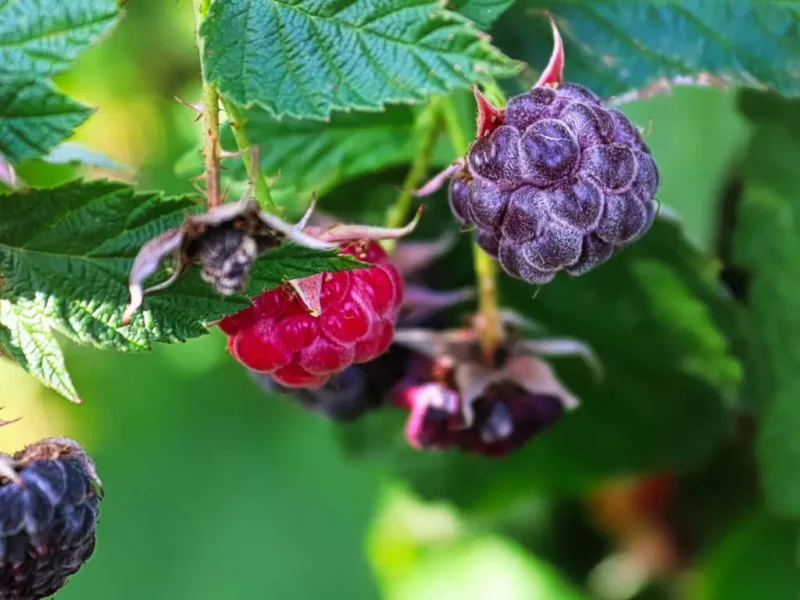If you’re looking to add something unique to your garden, look no further than the Glencoe raspberry. This stunning raspberry variety, with its rich purple hue, is a cross between red and black raspberries, bringing the best of both flavors. Ideal for small spaces and containers, the Glencoe Raspberry is not only compact but also easy to care for if you follow a few essential tips.
In this guide, you’ll learn everything about how to grow Glencoe raspberry, from planting and watering to pruning and harvesting. Whether you’re a seasoned gardener or a beginner, these insights will help you enjoy a bounty of delicious berries.
About Glencoe Raspberry

Key Features
-
Scientific Name: Rubus idaeus x occidentalis
-
Mature Size: 3-4 feet tall, 2-3 feet wide
-
USDA Growing Zones: 5-9
-
Expected Planting Period: Spring for bare-root plants, early fall in milder climates
-
Days to Maturity: Begins producing in 1-2 years after planting
-
Growth Rate: Moderate to fast once established, steady growth in full sun
-
Fruit Season: Mid-summer (usually late June to early July)
-
Attributes: Unique purple fruit, compact and thornless, ideal for small spaces and container gardening, excellent disease resistance, flavorful, and versatile for fresh eating or preserves.
Why Choose Glencoe Raspberry?

Developed in Scotland, it has a unique purple color and combines the sweetness of red raspberries with the robust flavor of black raspberries. Because of its compact and thornless nature, Glencoe raspberry plants are perfect for gardeners with limited space, making them an ideal option for container gardening. Whether you love eating fresh berries or using them in recipes, the Glencoe raspberry is sure to please.
How to Plant Glencoe Raspberry
To successfully grow Glencoe raspberry, creating the right environment is essential. This variety thrives under specific conditions:
Climate Compatibility
Glencoe raspberries grow well in USDA hardiness zones 5-9, which cover much of the United States. They prefer mild to moderate climates. In extremely hot regions, plant them where they receive morning sunlight and afternoon shade to protect them from intense heat. In colder zones, using mulch helps insulate the roots.
Soil Requirements
Glencoe raspberries need well-draining, nutrient-rich soil with a pH between 5.5 and 6.5. Adding organic compost or aged manure before planting enhances soil quality and improves growth. Good drainage is crucial to prevent root rot, a common issue for raspberry plants.
Sunlight Needs
For optimal growth, plant Glencoe raspberry bushes in a spot that receives full sunlight—at least 6-8 hours per day. While they tolerate partial shade, especially in hotter climates, more sunlight typically results in sweeter, larger berries.
Step-by-Step Planting Guide for Glencoe Raspberry
Container and Space Planning
One of the perks of the Glencoe raspberry is its compact size, making it perfect for smaller gardens and containers. When planting in containers, choose pots with a minimum depth of 12-18 inches and ensure good drainage. If planting directly in the garden, space the bushes 2-3 feet apart for adequate airflow and sunlight.
Planting Technique
To plant Glencoe raspberry bushes:
-
Dig a hole slightly larger than the plant’s root ball.
-
Position the plant so the roots spread out evenly, then cover with soil, ensuring the crown is at ground level.
-
Mulch around the base to retain moisture, keep roots cool, and prevent weeds.
Watering Instructions
Keep the soil consistently moist but not soggy, especially during the establishment period. Water deeply once a week, adjusting based on rainfall. Using a drip irrigation system or soaker hose can prevent water from splashing onto leaves, which helps reduce disease risk.
How to Grow Glencoe Raspberry
Proper Glencoe raspberry care ensures a healthy plant with a good yield each season.

Pruning Techniques
As a summer-bearing raspberry, Glencoe requires specific pruning to maintain productivity. After fruiting, prune the canes that bore fruit back to ground level in late summer or early fall. Leave new canes to bear fruit the following year. Regular pruning also promotes better airflow, reducing the risk of disease.
Fertilizing
Glencoe raspberries benefit from an organic fertilizer, like compost or aged manure, applied in early spring. This gives the plants the nutrients needed for healthy growth. Avoid over-fertilizing, as this can lead to excessive leafy growth with fewer berries.
Seasonal Care
In winter, apply a layer of mulch to protect the roots in colder areas. Remove this layer in spring to prevent moisture buildup, which can lead to rot. Consistent seasonal care will help maintain plant health and yield year-round.
Pest and Disease Management
Raspberries can be prone to certain pests and diseases, but there are effective, organic ways to protect them.
Common Pests
Pests like Japanese beetles and aphids can affect Glencoe raspberries. Neem oil or insecticidal soap works well as a natural treatment, and companion planting with garlic or onions can help deter pests.
Disease Prevention
Root rot and cane blight are common issues. To avoid these, ensure proper spacing and airflow around plants, and avoid overhead watering. Regular pruning and cleaning up fallen debris around the plants can further help reduce disease risks.
Troubleshooting Common Issues
Even experienced gardeners can encounter issues when they grow Glencoe raspberry. Here are some solutions to typical problems.
Small or Sour Berries
If your berries are small or lack sweetness, they may not be receiving enough sunlight, or the soil may need amending. Adding organic compost or adjusting watering can improve berry quality.
Low Productivity
Low yield can result from overcrowding or a lack of nutrients. Ensure plants are spaced correctly and consider adding a balanced organic fertilizer if growth seems sluggish.
Watering Challenges
Overwatering or underwatering can both harm raspberry plants. Maintain a consistent watering schedule, adjusting based on climate and rainfall. Mulching helps retain moisture, reducing the need for frequent watering.
Read more: How to Grow Glencoe Raspberry in Containers
Harvesting and Storage

Once the plants mature, you’ll be rewarded with a delicious harvest. Here’s how to get the most from your Glencoe raspberries.
When to Harvest
Harvest Glencoe raspberries when they’re fully colored and easily pull off the stems. Typically, they’re ready in mid-summer. Picking berries in the morning helps preserve their freshness.
Proper Harvesting Techniques
Gently twist each berry off the cane to avoid damaging the plant. Since they’re delicate, handle with care to prevent bruising. Harvest regularly to encourage further fruiting.
Storage Tips
Freshly picked Glencoe raspberries can be stored in the refrigerator for up to 5 days. For longer storage, freeze them in a single layer on a baking sheet before transferring them to a freezer bag. This prevents clumping and preserves their shape.
Frequently Asked Questions
1. What makes Glencoe raspberry unique compared to other raspberry varieties?
Glencoe raspberry is a hybrid between red and black raspberries, resulting in a rich purple color and a balanced sweet-tart flavor. It is compact, thornless, and ideal for small spaces or container gardening, making it especially versatile for home gardens.
2. What are the ideal growing conditions for Glencoe raspberry?
Glencoe raspberry thrives in USDA zones 5-9, with full sunlight (6-8 hours a day). It prefers well-draining soil with a pH between 5.5 and 6.5. Adding organic compost or aged manure improves soil health and drainage, helping prevent root rot.
3. How often should I water Glencoe raspberry plants?
Water Glencoe raspberries deeply once a week, ensuring the soil remains consistently moist but not soggy. Adjust watering based on climate, using mulch to retain moisture in hotter regions and to protect roots in colder climates.
4. When and how should I prune Glencoe raspberry plants?
After fruiting in summer, prune the canes that bore fruit down to the ground. This promotes new growth for next season. Regular pruning improves airflow, reduces disease risk, and encourages better yields.
5. What pests and diseases commonly affect Glencoe raspberries, and how can I manage them organically?
Common pests include Japanese beetles and aphids, while diseases like root rot and cane blight can also affect the plants. Use neem oil or insecticidal soap for pest control and maintain proper spacing and airflow to reduce disease risk. Companion planting with garlic or onions can further deter pests.
Conclusion
Growing Glencoe raspberries can be a rewarding experience, offering a unique addition to your garden with its purple berries and complex flavor. By following these care tips and troubleshooting common issues, you can enjoy a successful harvest season after season.
Ready to add a unique twist to your garden with the flavorful Glencoe raspberry? Start your planting journey today and enjoy the rewards of homegrown berries with our complete guide. SHOP NOW
Related post: The Ultimate Guide to Sweetie Pie Blackberry Care and Growing
